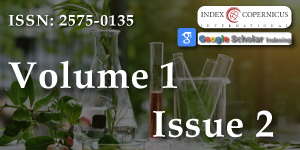Chlorophylls and xanthophylls of crop plants as dyes for Dye-Sensitized Solar Cells (DSSC)
Main Article Content
Abstract
Natural dyes have become a viable alternative to expensive and rare organic sensitizers because of their low cost, easy attainability, abundance of supply of raw materials and environmental friendliness. Chlorophyll, the most abundant pigment, can be extracted from plant leaves with simple and inexpensive methods, but it’s difficult to use as a Dye-Sensitized Solar Cells (DSSC) sensitizer due to the absence of OH and COOH groups. The opposite is true for xanthophylls, a particular class of carotenoids that contain free hydroxyl groups and thus may be considered as potential DSSC sensitizers. In this work we describe a new and inexpensive method of chlorophyll extraction from leaves based on the use of a basic solvent that provides the creation of COOH groups, allowing chlorophyll binding on the TiO2 layer. This modified chlorophyll dye showed a higher DSSC efficiency level (0.72%) compared to xanthophylls, which had lower efficiency.
Article Details
Copyright (c) 2017 Rossi M, et al.

This work is licensed under a Creative Commons Attribution 4.0 International License.
The Journal of Plant Science and Phytopathology is committed in making it easier for people to share and build upon the work of others while maintaining consistency with the rules of copyright. In order to use the Open Access paradigm to the maximum extent in true terms as free of charge online access along with usage right, we grant usage rights through the use of specific Creative Commons license.
License: Copyright © 2017 - 2025 |  Open Access by Journal of Plant Science and Phytopathology is licensed under a Creative Commons Attribution 4.0 International License. Based on a work at Heighten Science Publications Inc.
Open Access by Journal of Plant Science and Phytopathology is licensed under a Creative Commons Attribution 4.0 International License. Based on a work at Heighten Science Publications Inc.
With this license, the authors are allowed that after publishing with the journal, they can share their research by posting a free draft copy of their article to any repository or website.
Compliance 'CC BY' license helps in:
| Permission to read and download | ✓ |
| Permission to display in a repository | ✓ |
| Permission to translate | ✓ |
| Commercial uses of manuscript | ✓ |
'CC' stands for Creative Commons license. 'BY' symbolizes that users have provided attribution to the creator that the published manuscripts can be used or shared. This license allows for redistribution, commercial and non-commercial, as long as it is passed along unchanged and in whole, with credit to the author.
Please take in notification that Creative Commons user licenses are non-revocable. We recommend authors to check if their funding body requires a specific license.
Grätzel M. Dye-sensitized solar cells. J. Photochem. Photobiol. C Photochem Rev. 2003; 4: 145-153. Ref.: https://goo.gl/hEhbBh
Narayan MR. Dye sensitized solar cells based on natural photosensitizers. Ren Sustainable Energy Rev. 2012; 16: 208-215. Ref.: https://goo.gl/mHhZPg
Calogero G, Bartolotta A, Di Marco G, Di Carlo A, Bonaccorso F. Vegetable-based dye-sensitized solar cells. Chem Soc Rev. 2015; 44: 3244-3294. Ref.: https://goo.gl/UK1TK2
Calogero G, Sinopoli A, Citro I, Di Marco G, Petrov V, et al. Synthetic analogues of anthocyanins as sensitizers for dye-sensitized solar cells. Photochem Photobiol Sci. 2013; 12: 883-894. Ref.: https://goo.gl/8nXhVK
Teoli F, Lucioli S, Nota P, Frattarelli A, Matteocci F, et al. Role of pH and pigment concentration for natural dye-sensitized solar cells treated with anthocyanin extracts of common fruits. J. Photochem. Photobiol. A Chem. 2016; 316: 24-30. Ref.: https://goo.gl/FmFnUs
Di Bari C, Forni C, Di Carlo A, Barrajón-Catalan E, Micol V, et al. Pigments for natural dye sensitized solar cells from in vitro grown shoot cultures. J Photonics Energy. 2017; 7: 025503. Ref.: https://goo.gl/ueyJ8b
Amao Y, Kato K. Chlorophyll assembled electrode for photovoltaic conversion device. Sci. Direct. Electrochimica Acta. 2007; 53: 42-45. Ref.: https://goo.gl/UuS3pS
Ritchie RJ. Consistent sets of spectrophotometric chlorophyll equations for acetone, methanol and ethanol solvents. Photosynth Res. 2006; 89: 27-41. Ref.: https://goo.gl/At9jPn
Hao S, Wu J, Huang Y, Lin J. Natural dyes as photosensitizers for dye-sensitized solar cells. Sol Energy. 2006; 80: 209-214. Ref.: https://goo.gl/QESYPi
Wang XF, Kitao O, Hosono E, Zhou H, Sasaki S, et al. TiO2- and ZnO-based solar cells using a chlorophyll a derivative sensitizer for light-harvesting and energy conversion. JPhotochem Photobiol.A. 2010; 210: 145-152. Ref.: https://goo.gl/GssJCr
Wang XF, Tamiaki H, Wang L, Tamai N, Kitao O, et al. Chlorophyll-a derivatives with various hydrocarbon ester groups for efficient dye-sensitized solar cells: static and ultrafast evaluations on electron injection and charge collection processes. Langmuir. 2010; 26: 6320-6327. Ref.: https://goo.gl/TP1Fo7
Kay A, Grätzel M. Artificial Photosynthesis. 1. Photosensitization of TiO2 Solar Cells with Chlorophyll Derivatives and Related Natural Porphyrins. J Phys Chem. 1993; 97: 6272-6277. Ref.: https://goo.gl/jTtLL5
Chang H, Wu HM, Chen TL, Huang KD, Jwo CS, et al. Dye-sensitized solar cell using natural dyes extracted from spinach and ipomoea. J Alloys Compounds. 2008; 495: 606-610. Ref.: https://goo.gl/uEqNNf
Suyitno S, Saputra TJ, Supriyanto A, Arifin Z. Stability and efficiency of dye-sensitized solar cells based on papaya-leaf dye. Spectrochim. Acta A Mol Biomol Spectrosc. 2015; 148: 99-104. Ref.: https://goo.gl/kuMcZW
Nagovitsyn IA, Chudinova GK, Komissarov GG. Effect of carotene on the photovoltaic and optical properties of Langmuir films of chlorophyll. Doklady Biochem Biophysics. 2001; 382: 1-3. Ref.: https://goo.gl/ANiWDN
Kartini I,Dwitasari L,Wahyuningsih T,Chotimah D, Wang L. Sensitization of xanthophylls-chlorophyllin mixtures on titania solar cells. Internat. J Sci Eng. 2015; 8: 109-114. Ref.: https://goo.gl/DNPdyt

